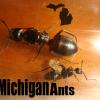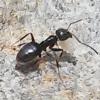Context: On 4/2/17 I found a solitary Prenolepis imparis worker out foraging on a rock. The rest of the ground was covered in dark leaf litter. I did not do an extensive search but was only able to find that one worker.
I kept the worker for observation for a day and set it free at the original rock the next day. I had planned to follow it back to its nest, but when I tapped the test tube gently it fell out of the tube and bounced off the rock. lol.
So my question is, how far will ants travel from their nest to forage? Is it likely that the nest will be close to where I found the worker or will it be miles away?
Edited by Cindy, April 6 2017 - 9:21 AM.
























